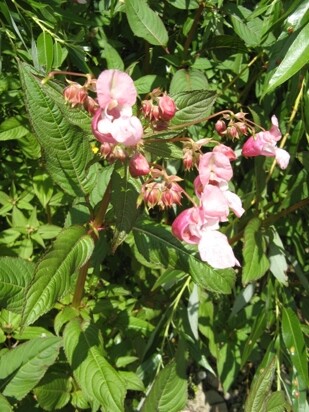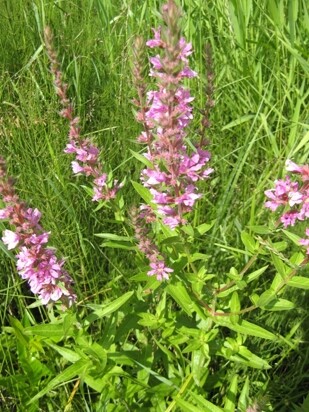Noxious Weeds
The Alberta Invasive Plants Council has developed a number of fact sheets that can be very helpful in recognizing invasive plants. Go to their website:https://abinvasives.ca/
The Alberta Invasive Plants Council has developed a number of fact sheets that can be very helpful in recognizing invasive plants. Go to their website:https://abinvasives.ca/

The weed you are surely referring to is Himalayan Balsam, Impatiens balsamifera. (I actually checked out Itaska beach on the way home from the PLWA AGM last Saturday and found some luscious clumps growing on the foreshore there. It is also abundant at Grandview and no doubt a few other places I haven't been to along Pigeon Lake shores.) It is an exotic-looking and extremely beautiful robust plant, and unfortunately some people don't want to get rid of it because it is so attractive, but it spreads extremely rapidly by seed (which can be transported by water) and forms monocultures which crowd out native species.
It is a huge pest in moist habitats in wetter climates such as BC and the U.K. As an annual it is easily pulled out by the root and residents should be encouraged to remove it, particularly before its pods, which open explosively to scatter the seeds, ripen.
Interestingly, there is a closely related plant, Touch-me-not, or Jewel-weed, which also forms extensive patches on the shores, but this will not be confused with the Himalayan Balsam because it has smaller, yellow flowers. This should not be removed. (I have a picture taken on the beach at Itaska with the exotic Himalayan Balsam and the native Touch-me-not growing side by side!)

One other "pink noxious weed" I should warn you about is Purple I saw one plant of this at Argentia Beach, though one or two people attending the workshops say they have seen it elsewhere. (And I am not generally familiar with the beaches around Pigeon.) This too is a tall attractive plant, but it should be removed immediately if seen. Being a perennial it travels less rapidly than Himalayan Balsam but once established and forming patches it is much harder to get rid of. It should not however be confused with the native and much commoner Fireweed, which occurs in much drier habitats (Purple Loosestrife occurs only on shores in marshes or in ditches).
It would be good if you could get your residents galvanized on pulling weeds - Tansy and Perennial Sowthistle are other problematic species, not to mention Canada Thistle.
